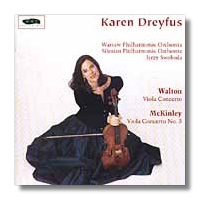
The Internet's Premier Classical Music Source
Related Links
- Latest Reviews
- More Reviews
-
By Composer
-
Collections
DVD & Blu-ray
Books
Concert Reviews
Articles/Interviews
Software
Audio
Search Amazon
Recommended Links
Site News
 CD Review
CD Review
Walton & McKinley

Viola Concertos
- William Walton: Viola Concerto *
- William Thomas McKinley: Viola Concerto #3
Karen Dreyfus, viola
* Warsaw National Philharmonic Orchestra/Jerzy Swoboda
Silesian Philharmonic Orchestra/Jerzy Swoboda
MMC Recordings MMC2047
William Walton's Viola Concerto, like Bartók's, is a sensuous and dusky work, burnished with two primary moods: sprightliness and meditation. Its opening Andante is colored with British pastoral mysticism, like a Turner painting. At times, its meditative mood morphs into a throaty mournfulness only a viola can capture. (A cello would have been too thick a brush for these delicate lines.) And if some of the orchestral segments seem gushy and old-fashioned, they are balanced by Walton's imaginative viola scoring. Karen Dreyfus plays with enthusiasm and energy. Her tone is tender in the final movement's cantabile and furious in the vivo con molto preciso. I would love to hear her handle the frenetics (and subtleties) of Hindemith's Kammermusik #5 and his viola sonatas, works that Kim Kashkashian interprets so brilliantly.
At first, this premier recording of William Thomas McKinley's Viola Concerto #3 made me wonder why he's written so many viola concertos. Does he play this rarely-featured instrument himself? Or is he just particular to its throaty, russet tones? No matter. If the other two concerti sound this good, then I eagerly await more recordings of his work. Viola Concerto #3 is complex, entertaining, stirring, and even witty at times. Jerzy Swoboda conducts the Silensian Philharmonic Orchestra with admirable precision, while Dreyfus festoons the piece with lamentation and sardonicism. McKinley calls his style "neo-tonal." I'm not sure what this means. Aren't all modern tonal composers neo-tonalists? The term that doesn't begin to describe his unique approach to thematic structure. The compulsive Largo has shapely ostinatos but no resolution, and toward the end of the piece Dreyfus' tremulandos convey an edgy intensity, then mysteriously disappear like albino beasts in a snow storm. Perhaps McKinley should write a manifesto and explain himself.
The final movement, Prestissimo e diabolico, is most impressive. McKinley's debt to jazz surfaces, as he floods the listener with streams of improvised, Paganini-like passages. Several times, the music explodes, loud and colorful, like a chrysanthemum firework. Surprising tempo shifts and constant structural invention keep this piece startling and fresh.
Copyright © 1998, Peter Bates


















